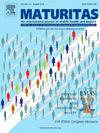Physical activity accumulated across adulthood and vasomotor symptoms in pre, peri, and postmenopausal women aged 40–48
IF 3.9
2区 医学
Q2 GERIATRICS & GERONTOLOGY
引用次数: 0
Abstract
Objectives
This study aimed to examine the associations between physical activity accumulated through adulthood and vasomotor symptoms (hot flushes and night sweats) of menopause in women aged 40–48.
Methods
Data from 6569 women in the 1973–78 cohort of the Australian Longitudinal Study on Women's Health (ALSHW) were analysed in 2024. Physical activity data were collected every three years from age 22–28 to 43–48. Participants were classified into low, moderate, and high levels of cumulative physical activity based on their reported activity across the surveys. The main outcome was the occurrence of vasomotor symptoms, specifically hot flushes and night sweats, reported by participants at age 40–48.
Results
At age 40–48, 21.4 % reported hot flushes (26.6 % low, 20.7 % moderate, 20 % high activity), and 25.5 % reported night sweats (27.7 % low, 24.9 % moderate, 25.0 % high activity). Women with moderate levels of cumulative physical activity from their early 30s to early 40s had 20 % lower odds of experiencing hot flushes than those with low activity levels (OR: 0.80, 95 % CI: 0.67–0.95). This association remained statistically significant after adjusting for sociodemographic factors (OR: 0.83, 95 % CI: 0.69–0.99) but was no longer significant after further adjustment for health-related factors, including alcohol consumption, body mass index, menopausal status, self-rated health, anxiety, and depression. No significant associations were found between cumulative physical activity and vasomotor symptoms for other life stages.
Conclusions
Although overall cumulative physical activity levels were not associated with vasomotor symptoms, moderate physical activity levels accumulated from the early 30s to early 40s were associated with lower odds of experiencing hot flushes.
求助全文
约1分钟内获得全文
求助全文
来源期刊

Maturitas
医学-妇产科学
CiteScore
9.10
自引率
2.00%
发文量
142
审稿时长
40 days
期刊介绍:
Maturitas is an international multidisciplinary peer reviewed scientific journal of midlife health and beyond publishing original research, reviews, consensus statements and guidelines, and mini-reviews. The journal provides a forum for all aspects of postreproductive health in both genders ranging from basic science to health and social care.
Topic areas include:• Aging• Alternative and Complementary medicines• Arthritis and Bone Health• Cancer• Cardiovascular Health• Cognitive and Physical Functioning• Epidemiology, health and social care• Gynecology/ Reproductive Endocrinology• Nutrition/ Obesity Diabetes/ Metabolic Syndrome• Menopause, Ovarian Aging• Mental Health• Pharmacology• Sexuality• Quality of Life
 求助内容:
求助内容: 应助结果提醒方式:
应助结果提醒方式:


